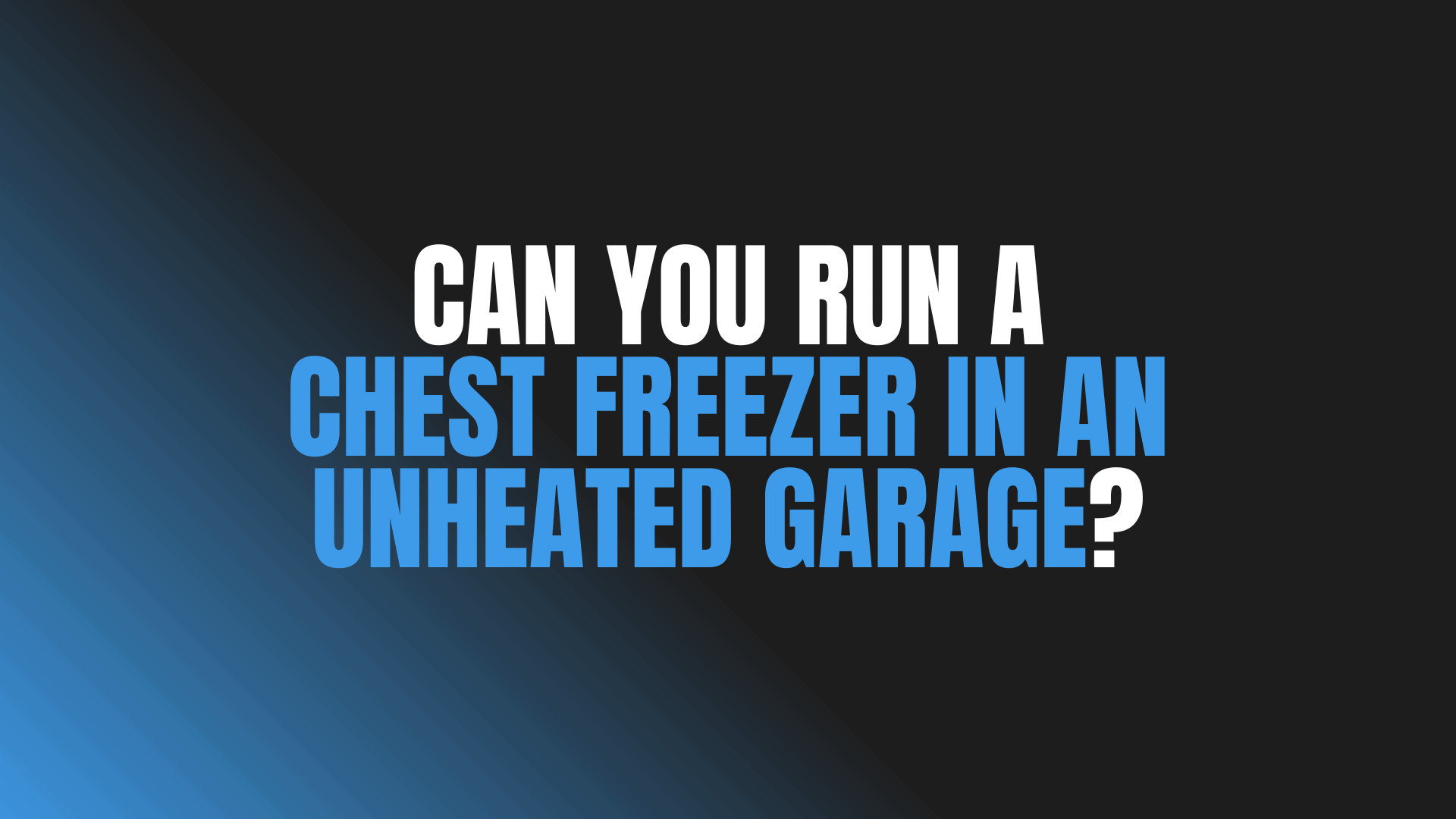
Question: Can You Run a Chest Freezer in an Unheated Garage?
Answer: Yes, you can run a chest freezer in an unheated garage, but it depends on the model and climate. Standard freezers can fail in temperatures below 32°F (0°C). For reliable performance in extreme cold or heat, you should purchase a “garage-ready” freezer specifically designed for wider temperature ranges. Always check the manufacturer’s operating temperature specifications.
Operating a Chest Freezer in a Cold Garage
Many homeowners wonder if they can run a chest freezer in an unheated garage. The garage seems like the perfect spot for extra food storage. It keeps bulky appliances out of the main living area and offers ample space. This question is particularly important for people living in climates with cold winters. An unheated garage can experience significant temperature drops, sometimes falling below freezing. These cold conditions create a unique challenge for standard appliances.
A chest freezer is designed to operate within a specific range of ambient temperatures. When you place it in an environment that is too hot or too cold, its performance suffers. While most people understand the problems caused by heat, the issues related to cold are less obvious. A very cold garage can trick a standard freezer into shutting off, which puts your frozen food at risk of thawing and spoiling. This can lead to hundreds of dollars in lost food and a major inconvenience.
Understanding how a freezer works helps clarify the problem. The appliance does not create cold; it removes heat. Its compressor circulates a refrigerant to pull warmth out of the insulated interior. A thermostat monitors the internal temperature and tells the compressor when to turn on. In an extremely cold garage, the external temperature can interfere with this essential process. This article explains the risks, provides solutions, and helps you decide if your garage is a suitable place for a chest freezer.
How Ambient Temperature Affects Freezer Operation
A chest freezer’s efficiency and reliability depend heavily on the temperature of the room where it is located. Manufacturers test their appliances to perform optimally within a certain temperature band, often between 10°C and 43°C. The air temperature surrounding the freezer is called the ambient temperature. This external temperature directly influences how hard the freezer’s compressor must work to maintain its internal cold setting.
When you place a freezer in a hot environment, like a garage during summer, the compressor runs more frequently. It works overtime to remove heat from inside the unit and combat the warmth seeping in from the outside. This constant operation increases energy consumption, leading to higher electricity bills. It also puts extra strain on the freezer’s mechanical parts, potentially shortening its lifespan. The compressor can overheat and fail if the ambient temperature is consistently too high.
Conversely, a cold environment presents a different set of problems. Most standard freezers use a single thermostat that measures the temperature of the air around the appliance. If the garage temperature drops close to or below the freezer’s target temperature, the thermostat may not signal the compressor to turn on. This inaction is the core reason you cannot run just any chest freezer in an unheated garage during winter.
Click here for more information on kitchen refinishing
Related Article: How Long Will a Full Chest Freezer Last Without Power?
Related Article: What to Know Before Buying a Chest Freezer?
Identifying Garage-Ready Chest Freezers
Appliance manufacturers recognize the need for freezers that can withstand garage conditions. They now produce special models known as “garage-ready” or “outbuilding-ready” freezers. These units are specifically engineered to function reliably in a wider range of ambient temperatures, often from -18°C up to 43°C. If you plan to keep a freezer in an unheated space, choosing one of these models is the most reliable solution.
Garage-ready freezers have several design features that allow them to handle temperature swings. They often include a built-in heater near the thermostat. This small heater gently warms the area around the sensor, ensuring it gets an accurate reading and triggers the compressor when needed, even if the garage is freezing. Additionally, these models may use more powerful compressors and special lubricants that remain fluid at lower temperatures. This combination of features ensures your food stays frozen and the appliance runs without undue mechanical stress.
When shopping, look for specific mentions of “garage-ready” or a stated operational temperature range on the product specifications. Do not assume any freezer can handle a cold garage. Investing in a purpose-built model provides peace of mind and protects your frozen goods all year round.
Tips for Using a Standard Freezer in a Garage
If you already own a standard chest freezer and want to use it in your garage, you can take certain steps to improve its chances of working correctly. While a garage-ready model is always the best choice, these tips can help mitigate the risks associated with cold ambient temperatures. These methods require regular attention, especially during the coldest months of the year. Success depends on your local climate and your garage’s specific conditions.
The primary goal is to keep the area around the freezer warm enough for the thermostat to function properly. You also want to help the freezer retain its internal temperature. A combination of monitoring and simple modifications can make a standard freezer viable in a moderately cold garage, but these are not guaranteed solutions for extreme climates.
Monitor Temperatures Closely
Place a thermometer inside your freezer and another one in the garage near the unit. Check both daily during cold spells. This allows you to confirm the freezer is maintaining its target temperature. If you notice the internal temperature rising, you know the compressor is not running often enough. An alarm-equipped freezer thermometer can provide an audible alert if the temperature rises above a safe level.
Use a Freezer Warming Kit
You can buy an aftermarket freezer warming kit. This device is essentially a small heating coil that you plug in and place near the freezer’s thermostat. It gently heats the air around the sensor, tricking the freezer into running its cooling cycle. This is a popular DIY solution, but ensure you follow the installation instructions carefully to avoid any safety hazards.
Improve Garage Insulation
Insulating your garage helps stabilize the ambient temperature. Adding insulation to the walls, ceiling, and garage door reduces extreme temperature swings. A more stable environment makes it easier for a standard freezer to operate correctly. Even a small, insulated enclosure built around the freezer can create a microclimate that stays just warm enough for the thermostat to work.
Keep the Freezer Full
A full freezer operates more efficiently than an empty one. The frozen items inside create thermal mass, which helps maintain the cold temperature. When the compressor does turn off, a full freezer will stay cold for a longer period. If you do not have enough food to fill it, use containers of water or bags of ice to take up the empty space. This reduces the workload on the compressor and helps protect your food if the unit stops running for a while.
Signs Your Garage Freezer Is Failing
You must regularly check your freezer for signs of trouble, especially when it is in an unheated garage during winter. Catching a problem early can save your food from spoiling. Be observant and investigate any changes in your freezer’s appearance or operation. Simple checks can alert you to a potential failure before it becomes a disaster. A failing freezer often provides several warning signs.
One of the most obvious signs is partially or fully thawed food. If your ice cream is soft or you see ice crystals forming on previously frozen items, the freezer is not maintaining a consistent, safe temperature. Another clear indicator is condensation or water droplets on the outside of the freezer or puddles on the floor around it. This suggests the unit is not cooling correctly and moisture is forming.
Listen for changes in the sounds your freezer makes. If the compressor, which normally hums quietly, is completely silent for long periods during a cold snap, the thermostat may not be activating it. Conversely, if the freezer runs constantly without cycling off, it could be a sign of a sealed system problem or another failure. Excessive frost buildup inside the freezer is another red flag. While some frost is normal, a thick layer of ice indicates a potential issue with the door seal or the cooling system.
Conclusion
You can run a chest freezer in an unheated garage, but you must choose the right type of freezer or take specific precautions. A standard freezer is not built to handle the cold temperatures of a Canadian winter. The cold air can prevent its thermostat from working correctly, causing the compressor to stop running. This inaction leads to thawed food and significant financial loss. The cold can also damage the compressor’s mechanical parts by thickening its lubricating oil, which can cause permanent failure.
The most reliable and worry-free solution is to purchase a “garage-ready” chest freezer. These models are engineered with features like internal heaters and robust components to perform flawlessly in a wide temperature range, from freezing cold to summer heat. By investing in an appliance designed for the environment, you protect your food and ensure the freezer has a long, efficient lifespan. This upfront investment provides peace of mind and saves you from potential future costs and frustrations.
If buying a new freezer is not an option, you can try to make a standard model work by monitoring temperatures, using a warming kit, or improving your garage’s insulation. Keeping the freezer full also helps it maintain a stable internal temperature. However, these are not foolproof methods. Ultimately, the decision depends on your climate and your willingness to actively manage the appliance. Protecting your frozen food supply starts with understanding how your freezer works and placing it in an environment where it can succeed.

Blue Malue Get in touch with Blue here.
